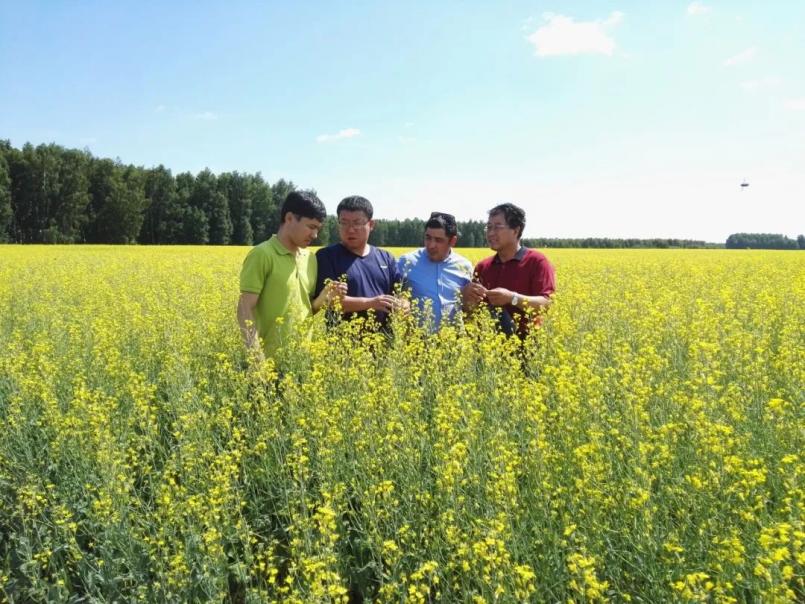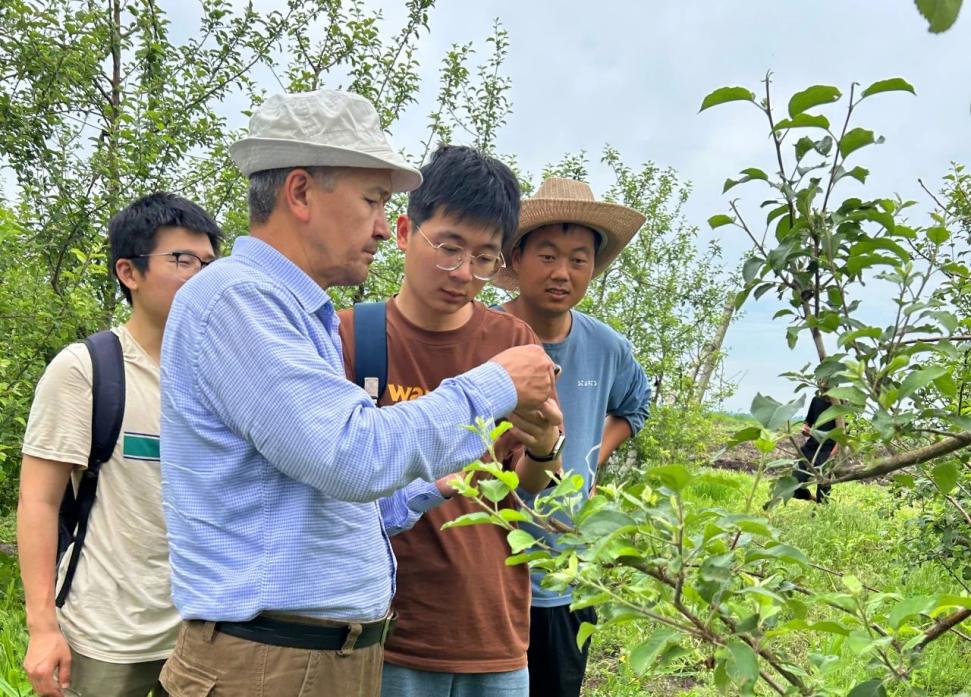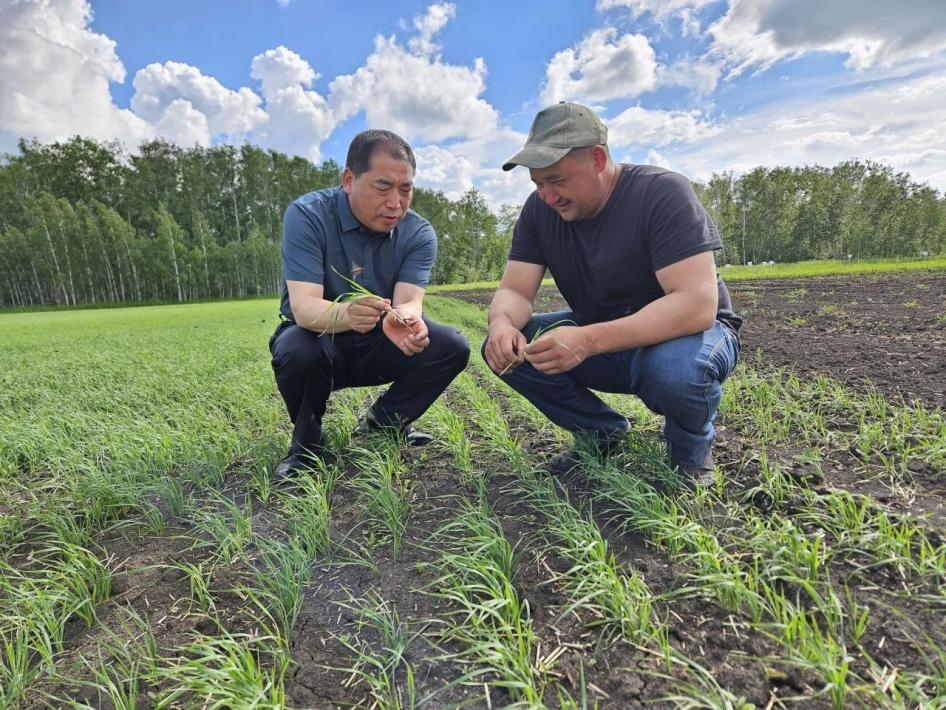Early this year, two standards jointly developed by China Northwest A&F University (hereinafter referred to as "NWAFU China"), the National Academy of Sciences of Belarus, and the National Academy of Agricultural Sciences of Belarus - Technical Regulations for Planting Sorghum for Winemaking and Technical Regulations for Pest and Disease Control of Foxtail Broomcorn Millet - were released in Belarus. This marks a milestone in deepening agricultural science, technology, and education cooperation between China and Belarus.
Led by Professor Feng Boli from the College of Agronomy at NWAFU China and his team, these two standards were jointly developed in collaboration with partners of the China-Belarus Agricultural Science and Technology Demonstration Park. At the demonstration park, experts from both China and Belarus have carried out identification and comprehensive evaluations of agronomic traits such as stress resistance, disease resistance, yield, and quality of crop germplasm resources including wheat, soybeans, and minor grains. They have screened out high-quality germplasm resources that align with the breeding objectives of countries along the Belt and Road Initiative, achieving a series of continuous and encouraging results.
The China-Belarus Agricultural Science and Technology Demonstration Park is one of eight demonstration parks jointly established by NWAFU China and Central Asian countries. These demonstration parks represent a significant milestone in China-Central Asia cooperation and exchange under the Belt and Road Initiative.
The Chinese Model Thrives in Central Asia
"The next morning, accompanied by two teachers from S. Seifullin Kazakh Agrotechnical University, our group visited a cooperative experimental station 18 kilometers outside Astana. The demonstration park is not large, covering 5 hectares. The land is dark and fertile, free from pollution." Mr. Bek explained that the soil here is all black soil, with an organic matter content generally between 3% and 5%. On May 23, 2017, Researcher Zhang Zhengmao from the College of Agronomy at NWAFU China wrote these words in his diary.
In mid-May of that year, Zhang Zhengmao, along with colleagues Han Qingfang and Huang Zhen, as the first experts team dispatched by the university, traveled abroad with 37 crop varieties across six categories including wheat, corn, rapeseed, buckwheat, and potatoes. They worked together on the joint establishment of an agricultural science and technology demonstration park with S. Seifullin Kazakh Agrotechnical University in Kazakhstan.

Experts Zhang Zhengmao and Guo Dongwei from Northwest A&F University examine the growth of rapeseed with local experts in the China-Kazakhstan Agricultural Science and Technology Demonstration Park.
Since 2005, NWAFU China has been exploring a new model for promoting agricultural science and technology innovations. This model involves building science and technology experimental demonstration stations in key agricultural areas, in collaboration with local governments. It brings together multi-disciplinary experts and students as well as local agricultural technology teams, to tackle critical challenges while demonstrating and promoting new technologies and achievements. This innovative approach has played a positive role in advancing agricultural development and increasing farmers' incomes in the arid regions of northwestern China.
This new agricultural technology promotion model has also attracted significant attention from science and technology delegations of Central Asian countries. These nations, like China's northwestern region, are situated in arid and semi-arid zones, with similar climatic conditions, ecological environments, and agricultural structures. Thus, they share common scientific and technological needs for agricultural development. It has become a common consensus to replicate China's successful model in Central Asia.
"After completing crop planting experiments and other tasks at the Astana Agricultural Science and Technology Demonstration Park in collaboration with S. Seifullin Kazakh Agrotechnical University, our team travel to Kazakh National Agrarian University to discuss the establishment of the Almaty Agricultural Science and Technology Demonstration Park with experts from the university," said Zhang Zhengmao.
Kazakh National Agrarian University is not only a leading agricultural university in Kazakhstan but also one of the top universities in Central Asia. Along with S. Seifullin Kazakh Agrotechnical University, it was among the founding members of the Silk Road Alliance for Agricultural Education, Science, and Technology Innovation (Silk Road Alliance), founded by NWAFU China in 2016.
"The experimental station of the National Agrarian University is located in Samsey Village, Kulen District, about 40 kilometers from Almaty, covering an area of over 1,300 hectares. This is where our demonstration park, in cooperation with the university, is situated. The land is dark, soft, and elastic. The experimental station mainly grows crops such as potatoes, wheat, corn, rapeseed, soybeans, and mung beans," Zhang Zhengmao introduced.
In early July 2017, NWAFU China and S. Seifullin Kazakh Agrotechnical University jointly inaugurated the demonstration park, marking the official establishment of the first China-Kazakhstan agricultural science and technology demonstration park in Astana. By 2019, NWAFU China had collaborated with Central Asian countries to establish eight overseas agricultural science and technology demonstration parks, covering multiple agricultural fields such as crops cultivation, water-saving irrigation, fruit trees, and biohealth.
Practical Cooperation Leads to Positive Outcomes
In late 2017, good news came from the China-Kazakhstan Agricultural Science and Technology Demonstration Park in Almaty, Kazakhstan's largest city: "The corn varieties introduced that year grew well and demonstrated great yield potential. Among them, Shandan 008, Shandan 8806, and Nongkeda No. 8 showed outstanding yield performance, reaching 12.9 tons, 12.1 tons, and 10.8 tons per hectare, respectively. These yields were 57.32%, 47.56%, and 31.7% higher than those of the local control varieties, showing a significant yield increase."
At the China-Uzbekistan Water-Saving Irrigation Agricultural Science and Technology Demonstration Park, Professor Zhu Delan from NWAFU China led a team of students and experts from Tashkent State Agrarian University to develop and promote solar-powered sprinklers, intelligent fertigation equipment, etc., leveraging the park's sufficient light conditions. These innovations changed the local past farming practice of flood irrigation, leading to a 50% increase in cotton yield, a 50% reduction in water usage, and a 40% decrease in investment costs.
NWAFU China has cooperated with universities and agricultural and livestock enterprises in Kyrgyzstan to build the China-Kyrgyzstan Fine Fruit Tree Breeding Demonstration Park. Since 2018, Zhang Dong, the chief expert of the demonstration park, has led his team on frequent trips between China and Kyrgyzstan to promote "special pollination tree varieties for apples" and the "intensive cultivation mode of apple dwarf rootstocks". Last year, 60,000 rootstock seedlings were transported from China over thousands of kilometers and successfully planted in the demonstration park. Zhang Dong said, "We aim to assist the Kyrgyz side in achieving standardized breeding of dwarf seedlings locally, which will help reduce orchard operation costs and improve production efficiency."

Professor Guba (second from left) from Kyrgyzstan National Agrarian University and postgraduate students from Professor Zhang Dong's team at NWAFU China conduct research at the China-Kyrgyzstan Agricultural Science and Technology Demonstration Park. Photo by Li Wenxia
Thanks to the high-quality Chinese crop varieties screened by the China-Kazakhstan Agricultural Science and Technology Demonstration Park, Xi'an Aiju Grain and Oil Industrial Group has implemented a 100,050-hectare contract farming project in Kazakhstan. Under the local extensive planting model, the wheat yield per hectare has increased from 1,200 kg to over 2,250 kg. Through the China-Europe Railway Express, Aiju Group transports high-quality wheat and edible oil from Kazakhstan to China, effectively promoting trade exchanges between the two countries.
The agricultural science and technology demonstration parks built at the doorstep of Central Asian countries, similar to China's "Science and Technology Courtyards," have become key platforms for scientific research cooperation, talent development, and cultural exchanges between China and Central Asian nations. Exchanges between the two sides have continuously increased, especially after the establishment of the SCO Agricultural Technology Exchange, Training and Demonstration Base in Yangling City, Shaanxi Province, China in 2019. Since then, such mutual engagement has become even more frequent.
As of November 2024, according to preliminary statistics, members of the Silk Road Alliance from Central Asian countries and NWAFU China have conducted nearly 400 mutual visits, involving over 900 experts and students. The two sides have jointly published more than 40 high-level research papers and developed 19 crop production standards and technical regulations, including the Cultivation Technical Specifications for Spring Wheat in Northern Kazakhstan. Additionally, the research focus of the science and technology demonstration parks has also expanded to fields such as pest control, animal husbandry and veterinary medicine, and saline-alkali land management and development.

Li Xuejun, a wheat breeding expert from NWAFU China, explains wheat seedling stage management to local technicians in the China-Kazakhstan Agricultural Science and Technology Demonstration Park.
Currently, the Silk Road Alliance's network has expanded to 120 scientific, educational institutions and enterprises across 19 countries. To date, 9 forums have been held in different member states and 5 professional sub-alliances have been established, including the Silk Road Wheat Innovation Alliance. Furthermore, 85% of NWAFU’s international students come from Belt and Road countries, with students from Central Asian countries accounting for 24% of the total.
Source
Farmers’ Daily March 25, 2025 https://mp.weixin.qq.com/s/XpuuXydibmyfmkqKMbM0_g
Related links
Category
Agricultural Demonstration Parks: A Platform for China-Central Asia Agricultural Cooperation
Contributor
Agricultural Demonstration Parks: A Platform for China-Central Asia Agricultural Cooperation
Country
Case Study

